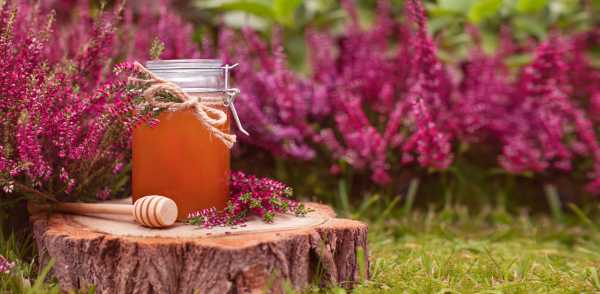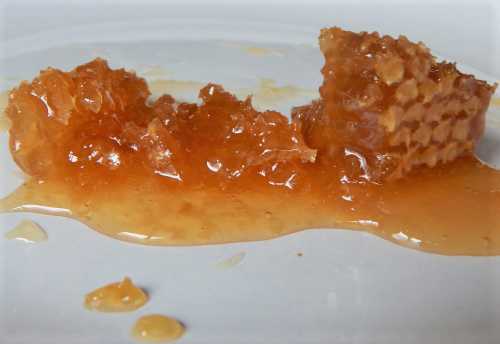Heather Honey: Characteristics. Types, Benefits
Heather honey is the common designation of honeys obtained from plants that belongs to the Ericaceae family1.
What Is Heather Honey?

There are different types of heather honey:
- heather honey made from nectar harvested by honey bees from the heath shrub, Erica such as Erica cinerea (sometimes referred to as bell honey); Erica manipuliflora, or honey Erica multiflora;
- heather honey made from nectar harvested by honey bees from ling heather, i.e. Calluna vulgaris - often referred to as 'ling honey'.
Characteristics Of Heather Honey
There may be differences in characteristics between heather honeys, depending on specific type, where grown, and whether the bees foraged on other flowers, as well as the heather.
However, ling honey from Calluna vulgaris is known to be jelly-like (thixotropic), and has to be bottled by beekeepers in a different way from the traditional methods, and a special heather honey press may be used in the process.
Bell honey (from Erica cinerea) is prepared in the same way as other honeys, and has a distinctive port-wine color.
Does one taste better than the other?
Just as the characteristics of heather honey may very, there may also be subtle differences in taste due to plant variant and growing conditions, as well as extent to which the honey is mono-floral or multi-floral.
No doubt, honey producers (and perhaps, their fellow countrymen or supporters) may believe and state that their heather honey is superior to the rest!
In any case, descriptions of heather honey vary.
For example, Dezmirean et al2 state:
"Heather (Calluna vulgaris) honey is a special type of honey, highly valued for its characteristic strong taste, unusual texture and health properties."
Xagoraris et al3 state:
"Erica manipuliflora is indigenous in Greece and is known as “autumn heather”....Greek autumn heather honey is well-known for its extraordinary aroma profile, characterized by perfume reminiscent “caramel” notes.."
I think taste is personal. Some people may prefer one over the other, whilst others like them all the same.
Where are heather moors found?
It's safe to say (without debating which heather is found where) that heather moors are especially found in Europe and especially northern Europe, and particularly in Britain and Ireland.
In any event, heather cultivars can be useful in bee gardens as they provide nectar and pollen for bees and other pollinators.
What are the benefits of heather honey?
Several studies outline a range of benefits, depending on the scope of the individual study. For example:
- according to one study, Portuguese heather honey (from C. vulgaris) contains high contents of phenolic compounds that may signal a strong antioxidant capacity1;
- heather honey (from C. vulgaris) has also been found to have an anti-bacterial profile comparable with honey used in the treatment of different bacterial infections2;
- heather honeys display bactericidal activity against Pseudomonas aeruginosa4; a bacteria which can cause infections in hospital patients, pneumonia, and infections in the blood or body after surgery.
Which heather honey is best?
It should be noted that whilst claims are made for heather honey, only a relatively small number of heather honey variants have been investigated scientifically, and methods as well as objectives of each study, may differ.
Therefore, at this stage, it's not necessarily useful to state that one heather honey is better than the other.
References
1. Rodrigues da Silva, L.; Campos Chisté, R.; Fernandes, E. Chemical and Antioxidant Characterization of the Portuguese Heather Honey from Calluna vulgaris. Separations 2021, 8, 177. https://doi.org/10.3390/separations8100177
2. Dezmirean, Daniel & Mărghitaş, Liviu & Fit, Nicodim & Chirilă, Flore & Gherman, Bogdan & Mărgăoan, Rodica & Aurori, Adriana & Bobis, Otilia. (2015). Antibacterial Effect of Heather Honey (Calluna vulgaris) against Different Microorganisms of Clinical Importance. Bulletin of University of Agricultural Sciences and Veterinary Medicine Cluj-Napoca. Animal Science and Biotechnologies. 72. 10.15835/buasvmcn-asb:10562.
3. Xagoraris M, Chrysoulaki F, Revelou PK, Alissandrakis E, Tarantilis PA, Pappas CS. Unifloral Autumn Heather Honey from Indigenous Greek Erica manipuliflora Salisb.: SPME/GC-MS Characterization of the Volatile Fraction and Optimization of the Isolation Parameters. Foods. 2021 Oct 17;10(10):2487. doi: 10.3390/foods10102487. PMID: 34681536; PMCID: PMC8535634.
4. Shirlaw O, Billah Z, Attar B, Hughes L, Qasaymeh RM, Seidel V, Efthimiou G. Antibiofilm Activity of Heather and Manuka Honeys and Antivirulence Potential of Some of Their Constituents on the DsbA1 Enzyme of Pseudomonas aeruginosa. Antibiotics (Basel). 2020 Dec 15;9(12):911. doi: 10.3390/antibiotics9120911. PMID: 33334017; PMCID: PMC7765399.
If you found this page helpful or interesting, I'd really be grateful if you would share it with others - if not this page, perhaps another, such as Gardening For Bees.
Thank you so much :) .
